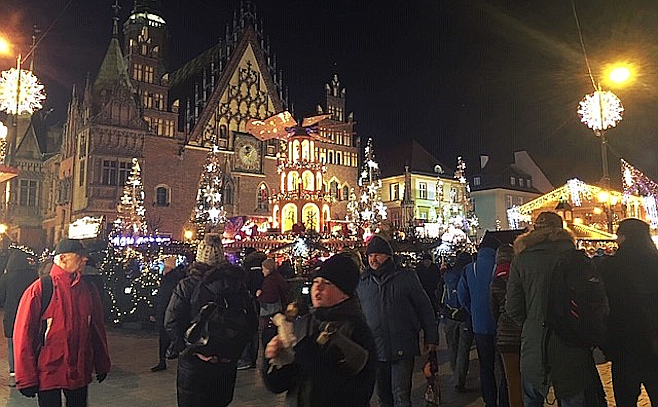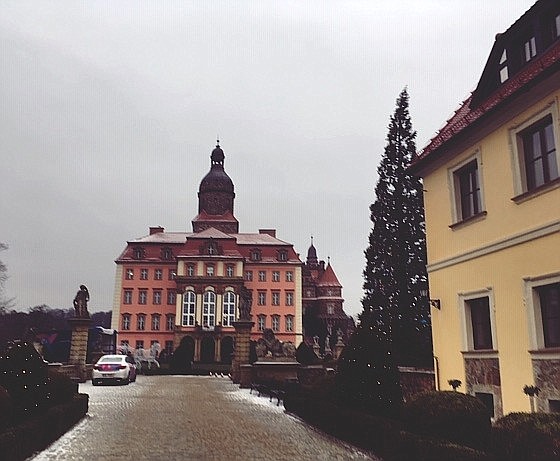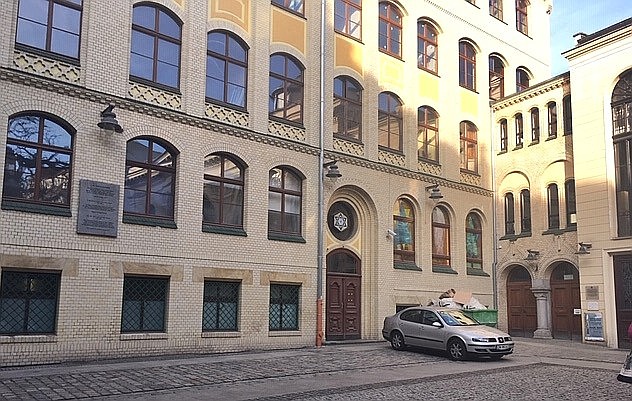 Facebook
Facebook
 X
X
 Instagram
Instagram
 TikTok
TikTok
 Youtube
Youtube

I visited Wroclaw, Poland, during an interesting time in history: it was the 100th anniversary of Poland’s independence, the 100th anniversary of the Armistice and the 80th anniversary of Kristallnacht.
As for Wroclaw itself, it has an ancient heritage. The town center is the crossroads of the pre-historic Amber Road and the medieval Via Regia (“King’s Road”).
It was more formally settled 1,200 years ago, passing through Bohemian (Czech) rulers onto Poland, to the Austrian-Hungarian Empire, to the Prussians, the Germans and the Nazis. After the Potsdam Conference in 1945, where the Soviets claimed large swaths of eastern Poland, it seemed fair to return what was Poland’s many years ago in the West. But rather than being a poor, awkward fit, Poland has brilliantly reclaimed its heritage and has proudly brought back its culture, architecture and cuisine.
The Novotel Wroclaw isn’t in the historic center, but still has a lot to recommend it. It’s across the street from a fashionable mall that dates from before WWII. The service desk is staffed by young, accommodating staff who understand English. (They offer use of a fee-free smartphone, which I probably should have taken advantage of.)
Their restaurant-bar area serves dinner until 11 pm and the bar is open until midnight; perfect for me, as I had missed two connecting flights. Though I have been disappointed with steak throughout Europe, something told me to give it another shot: the ribeye dinner was a treat! It was well marbled, properly seasoned and served with a sizeable house salad and house-made fries. I also had a slice of tomato cake with ginger glaze, garnished with beautiful fresh fruits and an orchid. They have a good selection of local microbrews.
A small fitness room with sauna is on the ground floor. I wore my “nice” bathing suit, all ready to relax after a chilly day walking around. But when I got to the sauna, there was a big sign saying that you could only wear a towel or “stay naked”. A bunch of athletic guys wrapped in towels were in the dark sauna. I went to a corner of one of the changing rooms – I couldn’t tell which was which – and held the towel up for size. No. Way.
Though I hear there are some fine ethnic restaurants, I seemed to find myself at places proud to feature Polish cuisine. Though you may be familiar with some of their staples from festivals – like pierogies – realize that the real deal utilizes more luxurious ingredients, such as wild game and fresh seafood. Also, with Wroclaw’s heritage, you’ll find Czech, Hungarian, German and Ukrainian influences on menus.
A young couple has started a brewery to bring back a beer style famous in Wroclaw – Schops – that dates from the 1500s. Schops is a dark wheat beer with honey and spice notes. Browar Stu Mostow is a very popular brewery and gastropub. Their small plates include hearty offerings like poultry livers and goose breast in ale.
Pod Fredra is right on the historic medieval town square, adjacent to City Hall and specializes in traditional Polish cuisine. It feels like it’s been there 200 years, though of course it hasn’t. Sausages are drying out front, with Slavic musical instruments adorning the walls. It’s charming. Order specialties like sour rye soup, pickled veggie salads and fried pierogies.
Malarska 25 has a regional chef winner at its helm. Though it’s casual, come-as-you-are, they’re doing Polish fare with a sophisticated twist: locally-sourced, house-made, modern takes on “grandma food.” Think duck offal dumplings, wild boar steak, venison goulash. Their own pickled vegetables figure prominently as garnishes.
Wroclaw Zoo dates back to 1865 Prussia and is now the most popular tourist attraction for Polish children to visit. The Africarium features creatures and flora from all of Africa. This is a modern-style zoo, recreating the natural habitats of the animals’ home, along with carefully mixing different species for a more natural existence. Wroclaw Zoo is doing important zoological work in the world. Not only do they strive to strengthen endangered species’ population, but they also keep exact husbandry records: it would not be good to mate relatives of these smaller gene pools.
The city’s biggest indoor market – Hala Targowa – has something for everyone. The building was completed in 1908 with reinforced concrete trusses, making it look a little like a post-modern church inside. The solid construction made it withstand bombing in WWII. The lower floor has gorgeous produce and flowers, no doubt from hothouses (or abroad) in the winter. There’s also a little jewel box of a café, as well as prepared foods booths that serve gargantuan portions for very modest prices. Upstairs are a bunch of curious and interesting shops, some with a flea market vibe. There was a fine leather goods store, a place selling traditional Polish crockery and even a lingerie store.

Visit and eat at a real castle: The last royal inhabitant of Zamak Książ was "Princess Daisy", divorcee' of Prince Hans Heinrich of Pless. As her husband was one of the richest men in Europe, she lavishly entertained the likes of Tsar Nicholas I, Emperor Franz Joseph, Prince Anthony Radziwill of Poland and even Winston Churchill. However, the money ran out, the visitors dried up and the Nazis kicked her out. Hitler had a plan in place to unearth the cliff on which the castle sits to create an underground city! There is a quirky antiques store on site, selling everything from Versace-like espresso cups to huge Gothic furniture pieces. The restaurant is where the stables were.
Check out Wroclaw’s dwarves: one-foot bronze statues representing freedom from Communism. The dwarves can be found all over, doing various things. There are online apps and scavenger hunt games to check in with them.

Just one synagogue in Wroclaw survived Hitler’s Kristallnacht, only because destroying it would have rendered neighboring buildings structurally unsound. White Stork Synagogue dates from 1829. Jews have been in the town for at least 1,000 years. Visit the museum and art exhibits during the day. The synagogue itself celebrates all the Jewish holidays and has wonderful Kabbalat Shabbat services with fellowship afterward: contact them ahead of your visit for times and protocol. I went right before Hanukkah. Men and women sit separately in the cozy basement synagogue room, with services mostly in Hebrew and Polish. I did wince in sadness when it turned out that only one elderly woman knew what a dreidel is: it showed how Hitler nearly obliterated the whole culture.

Right in the historic city center, they’ve revived a 13th century tradition: the Wroclaw Christmas Fair. The place really comes alive at night — even for little kids. There are rides, puppetry of the classic Brothers Grimm tales, plus the city dwarfs walking around. For grown-ups, hot mulled wine is the traditional drink, even more popular with a splash of rum! There’s kind of a chalet where you buy it (or other hot drinks) in souvenir mugs. The balcony overlooks the whole market.
Vendors are carefully selected to be artisanal and local or regional, giving an opportunity to buy the famous Polish hams and sausages.
In ancient times, amber, called “the gold of the north,” was found in the Baltic region and Wroclaw, then traded as far as Egypt! Tutankhaman’s tomb was filled with amber from the area. I learned that Wroclaw is renowned for having the finest quality amber, because it comes from rivers with less salt content, thus having fewer occlusions. So, of course, some had to come home with me.


I visited Wroclaw, Poland, during an interesting time in history: it was the 100th anniversary of Poland’s independence, the 100th anniversary of the Armistice and the 80th anniversary of Kristallnacht.
As for Wroclaw itself, it has an ancient heritage. The town center is the crossroads of the pre-historic Amber Road and the medieval Via Regia (“King’s Road”).
It was more formally settled 1,200 years ago, passing through Bohemian (Czech) rulers onto Poland, to the Austrian-Hungarian Empire, to the Prussians, the Germans and the Nazis. After the Potsdam Conference in 1945, where the Soviets claimed large swaths of eastern Poland, it seemed fair to return what was Poland’s many years ago in the West. But rather than being a poor, awkward fit, Poland has brilliantly reclaimed its heritage and has proudly brought back its culture, architecture and cuisine.
The Novotel Wroclaw isn’t in the historic center, but still has a lot to recommend it. It’s across the street from a fashionable mall that dates from before WWII. The service desk is staffed by young, accommodating staff who understand English. (They offer use of a fee-free smartphone, which I probably should have taken advantage of.)
Their restaurant-bar area serves dinner until 11 pm and the bar is open until midnight; perfect for me, as I had missed two connecting flights. Though I have been disappointed with steak throughout Europe, something told me to give it another shot: the ribeye dinner was a treat! It was well marbled, properly seasoned and served with a sizeable house salad and house-made fries. I also had a slice of tomato cake with ginger glaze, garnished with beautiful fresh fruits and an orchid. They have a good selection of local microbrews.
A small fitness room with sauna is on the ground floor. I wore my “nice” bathing suit, all ready to relax after a chilly day walking around. But when I got to the sauna, there was a big sign saying that you could only wear a towel or “stay naked”. A bunch of athletic guys wrapped in towels were in the dark sauna. I went to a corner of one of the changing rooms – I couldn’t tell which was which – and held the towel up for size. No. Way.
Though I hear there are some fine ethnic restaurants, I seemed to find myself at places proud to feature Polish cuisine. Though you may be familiar with some of their staples from festivals – like pierogies – realize that the real deal utilizes more luxurious ingredients, such as wild game and fresh seafood. Also, with Wroclaw’s heritage, you’ll find Czech, Hungarian, German and Ukrainian influences on menus.
A young couple has started a brewery to bring back a beer style famous in Wroclaw – Schops – that dates from the 1500s. Schops is a dark wheat beer with honey and spice notes. Browar Stu Mostow is a very popular brewery and gastropub. Their small plates include hearty offerings like poultry livers and goose breast in ale.
Pod Fredra is right on the historic medieval town square, adjacent to City Hall and specializes in traditional Polish cuisine. It feels like it’s been there 200 years, though of course it hasn’t. Sausages are drying out front, with Slavic musical instruments adorning the walls. It’s charming. Order specialties like sour rye soup, pickled veggie salads and fried pierogies.
Malarska 25 has a regional chef winner at its helm. Though it’s casual, come-as-you-are, they’re doing Polish fare with a sophisticated twist: locally-sourced, house-made, modern takes on “grandma food.” Think duck offal dumplings, wild boar steak, venison goulash. Their own pickled vegetables figure prominently as garnishes.
Wroclaw Zoo dates back to 1865 Prussia and is now the most popular tourist attraction for Polish children to visit. The Africarium features creatures and flora from all of Africa. This is a modern-style zoo, recreating the natural habitats of the animals’ home, along with carefully mixing different species for a more natural existence. Wroclaw Zoo is doing important zoological work in the world. Not only do they strive to strengthen endangered species’ population, but they also keep exact husbandry records: it would not be good to mate relatives of these smaller gene pools.
The city’s biggest indoor market – Hala Targowa – has something for everyone. The building was completed in 1908 with reinforced concrete trusses, making it look a little like a post-modern church inside. The solid construction made it withstand bombing in WWII. The lower floor has gorgeous produce and flowers, no doubt from hothouses (or abroad) in the winter. There’s also a little jewel box of a café, as well as prepared foods booths that serve gargantuan portions for very modest prices. Upstairs are a bunch of curious and interesting shops, some with a flea market vibe. There was a fine leather goods store, a place selling traditional Polish crockery and even a lingerie store.

Visit and eat at a real castle: The last royal inhabitant of Zamak Książ was "Princess Daisy", divorcee' of Prince Hans Heinrich of Pless. As her husband was one of the richest men in Europe, she lavishly entertained the likes of Tsar Nicholas I, Emperor Franz Joseph, Prince Anthony Radziwill of Poland and even Winston Churchill. However, the money ran out, the visitors dried up and the Nazis kicked her out. Hitler had a plan in place to unearth the cliff on which the castle sits to create an underground city! There is a quirky antiques store on site, selling everything from Versace-like espresso cups to huge Gothic furniture pieces. The restaurant is where the stables were.
Check out Wroclaw’s dwarves: one-foot bronze statues representing freedom from Communism. The dwarves can be found all over, doing various things. There are online apps and scavenger hunt games to check in with them.

Just one synagogue in Wroclaw survived Hitler’s Kristallnacht, only because destroying it would have rendered neighboring buildings structurally unsound. White Stork Synagogue dates from 1829. Jews have been in the town for at least 1,000 years. Visit the museum and art exhibits during the day. The synagogue itself celebrates all the Jewish holidays and has wonderful Kabbalat Shabbat services with fellowship afterward: contact them ahead of your visit for times and protocol. I went right before Hanukkah. Men and women sit separately in the cozy basement synagogue room, with services mostly in Hebrew and Polish. I did wince in sadness when it turned out that only one elderly woman knew what a dreidel is: it showed how Hitler nearly obliterated the whole culture.

Right in the historic city center, they’ve revived a 13th century tradition: the Wroclaw Christmas Fair. The place really comes alive at night — even for little kids. There are rides, puppetry of the classic Brothers Grimm tales, plus the city dwarfs walking around. For grown-ups, hot mulled wine is the traditional drink, even more popular with a splash of rum! There’s kind of a chalet where you buy it (or other hot drinks) in souvenir mugs. The balcony overlooks the whole market.
Vendors are carefully selected to be artisanal and local or regional, giving an opportunity to buy the famous Polish hams and sausages.
In ancient times, amber, called “the gold of the north,” was found in the Baltic region and Wroclaw, then traded as far as Egypt! Tutankhaman’s tomb was filled with amber from the area. I learned that Wroclaw is renowned for having the finest quality amber, because it comes from rivers with less salt content, thus having fewer occlusions. So, of course, some had to come home with me.
Comments